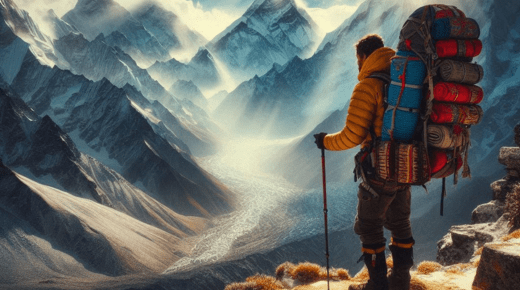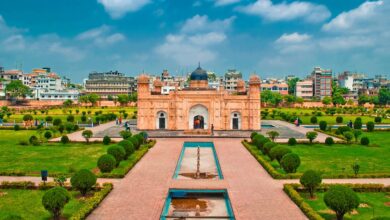How a Sherpa Enhances Your Gokyo and Everest Base Camp Trekking Experience

For any adventurous heart, a trek to Everest Base Camp and Gokyo Lakes is the ultimate dream come true, where witnessing hypnotic vistas and relentless thrilling challenges that bind you to the heart and soul of nature. But one of the biggest lifts to the whole experience is trekking with a Sherpa guide. Not just any companion, though: Sherpas, the Indigenous people of Kthe humbug region, know the terrain, weather, and culture best of the Himalayas; add to it the qualities of being hard-working and daring, they become an invaluable companion on such a worldly hazardous journey.
Gokyo Everest Base Camp trek trail guide Sherpas help you on the trail in many different ways, safety being the first priority. They are experts in high-altitude accommodation, a vital part of a successful visit to Everest Base Camp or Gokyo Lakes. Sherpas know the right pace to trek to avoid high-altitude sickness and rest and can tailor the duration of the trek at elevations to minimize the danger of high-altitude hiking. Not only is their presence reassuring because you’re in the care of someone who knows the challenges that this part of the world presents, but they also respond to emergencies, from first aid to, if necessary, organizing evacuations.
Sherpas themselves provide a wealth of cultural knowledge that can truly enrich and deepen your experience of the trek, beyond just safety. They tell stories about the mountains’ significance, the sacred traditions of the Sherpa peoples, and local monasteries, rituals, and festivals. In this cultural phenomenon, the trek transforms into something much greater than a physical journey but ultimately a spiritual, educational idea.
Moreover, they are also invaluable in guiding us through the logistics of the trek. They take care of the route planning, accommodation, and meal options, moving seamlessly from one spot to the next. They know the local tea houses and trails and have the experience to make your trek as comfortable and speedy as it can be. Now you are free to relish in the majesty and intensity of the Himalayas knowing that all the logistics are taken care of by a Sherpa.
The Role of the Sherpa — an Introduction
EBC Trek The Sherpa are an ethnic group that live in the Himalayas region, particularly in Nepal, and are a large part of the business of trekking and mountain climbing. Sherpas are known for their incredible strength, endurance , and intimate understanding of the mountains, and are therefore considered the best guides for trekking out to places like Everest Base Camp and Gokyo Lakes. They do much more than lead trekkers along the routes; they are expert navigators, cultural envoys, and safety specialists. Sherpas are intimately acquainted with the terrain, weather, and challenges of high-altitude trekking. They are now known worldwide for their ability to transport heavy items, organize logistics, and assist during emergencies. Plus, Sherpas are experts at acclimatization and understand how to help trekkers adjust to the thinning air of the high mountains. For trekkers who are tackling the strenuous trek to the base of Mount Everest or the pristine serenity of the Gokyo Lakes, a Sherpa at your side makes the experience more seamless, safer, and more enlightening. Their deep ties to the mountains and their culture give trekkers a unique vantage point from which to learn about the region’s history, traditions, and spirituality. In conclusion, the Sherpa serves multiple purposes in addition to facilitating local climbs by sharing the true essence and character of incredible routes.
Navigation and route planning expertise
A Sherpa plays an important role which involves a lot of things but one of the most important is navigation and route planning. The Everest and Gokyo region is a complex landscape that needs detailed knowledge of the trails, weather patterns, and topography to navigate. With generations of life and work in the Himalayas, Sherpas have a unique knowledge of the land. These guides really know the best routes, what the seasonal conditions are like, and what areas to avoid to keep trekkers on schedule and out of danger zones like avalanches or landslides. This understanding is particularly important in the Everest region, where the landscape can shift significantly from day to day. A Sherpa’s skill in charting the best path for each individual group is a crucial element of the trek’s success. Their itineraries allow for the specific fitness and acclimatization needs of the group, and you will work with the organization to adapt to seasonal conditions. In places where the way isn’t as clearly marked, or when the weather becomes uncooperative, a Sherpa’s local knowledge and experience become essential. They know when to slow things down and take rest breaks so that trekkers don’t overdo it. Indispensable for foreign adventurers, a Sherpa guides fearless adventurers through the intricacies of the dangerous highland.
How to keep safe at soaring heights
EBC Cho La Pass trek difficulty A Sherpa’s primary job is to keep trekkers safe in the high-altitude conditions of the Everest Base Camp and Gokyo Lakes regions. On these treks, concerns about altitude sickness, extreme weather, and unpredictable terrain mean safety is paramount. Having grown up in the mountains, the Sherpa has an instinctive feel for how the human body is affected by altitude. They are trained in when to recognize symptoms of altitude sickness — including dizziness, headaches, and shortness of breath — and how to manage these symptoms and keep a close eye on trekkers for poison control. This knowledge enables them to make important decisions like altering the itinerary or suggesting rest days to ensure trekkers acclimatize and stay away from altitude sickness. For emergency situations, Sherpas are trained in first aid and often act as first responders. Their knowledge of the terrain also helps them act quickly when an accident or injury occurs to reduce risks and help trekkers get the medical care they need. Sherpas are also adept at leading trekkers through demanding terrains, helping them safely traverse steep slopes, icefalls, and glaciers. Sherpas are invaluable in preserving the health and safety of clients, so trekkers can continue to enjoy the experience without ruminating about their well-being.
Offering Insights on Local Culture
Sherpas are not only expert mountain guides but also valuable cultural ambassadors, providing trekkers with profound insight into the beauty, history, and spirituality of the region. As the indigenous folk of the Khumbu region, Sherpas share a special bond with the land, and their knowledge of the local culture is inter-generational. Sherpas offers trekkers a unique window into the lifestyle and beliefs of the Sherpa people while trekking to Everest Base Camp or Gokyo Lakes. They tell you about their people, their ancestry, how prevalent Buddhism is in their everyday lives, and the mountains’ sacred significance. Many Sherpas are also monks, or have close ties to local monasteries, providing trekkers with deep insight into the spiritual side of the Himalayas. They frequently welcome climbers to Buddhist stupas, prayer flags, and monasteries along the trail, accompanying the trek with spiritual experiences in addition to a physical challenge. In a region where adherence to local customs is essential, Sherpas usually provide invaluable information on local customs, etiquette, and traditions. With their guidance in this, trekkers will leave with a richer purpose behind physically pushing their limits and experiencing a whole different culture on the trek and a more personal connection with the land and community.
This Dog is Not Just a Pet: Helping with Physical and Mental Endurance
Proper Everest Base Camp or Gokyo Lakes trek is physically intense because it needs a lot of stamina along with strong willpower. Sherpas are a key part of supporting trekkers through the physical challenges of the trip as well as the mental strains of high-altitude trekking. Physically, they make sure that the trekkers keep a reasonable pace, taking breaks as necessary, and encourage them to get through the tough sections. Sherpas are expert motivators, their experience helping trekkers maintain their energy levels, particularly on long days when exhaustion starts to creep in. They’re a comfort, both emotionally and tangibly, when grueling excursions are long, steep, windy hours and mental weariness or doubt sets in., Physical and mental stamina: In the cruel atmosphere of high altitude, the physical body can be pushed to its limits and simply having the mental endurance to persist in even dangerous conditions can be intensely demanding. Sherpas are also experienced guides, but they are likewise kindred spirits who understand the psychological pressure trekking at altitude can impose. They know when to encourage when to offer silent support, and when to change or adjust the pace or schedule to give trekkers the mental and physical space required. Their familiarity also extends to altitude sickness, which can produce irritability and anxiety. They keep the trekkers on track, reminding them to hydrate and keep a positive mindset to ensure that trekkers overcome the physical and mental challenges of the trail.
Help with Acclimatisation
Sherpas are so important in high-altitude trekking, not just for their strength/muscles, but also being your guides and enabling you to acclimatize. At high altitudes, the air is less dense, and the body needs to acclimatize to lower levels of oxygen. Because of their deep knowledge of how high altitude impacts the body, sherpas reduced the danger of high-altitude sickness by prescribing rest days to accommodate individual needs and avoiding a breakneck pace so the body can properly adjust to its new conditions. They know that moving too fast or too hard can result in serious health problems, so they structure the trek to guarantee trekkers slowly advance, allowing their bodies time to acclimatize to higher altitudes. Along the way, Sherpas screen trekkers for early indications of altitude sickness — headaches, nausea, and dizziness, for example — and take advice based on their knowledge and experience. They are also trained to recognize the signal of more serious conditions like high-altitude pulmonary edema (HAPE) or high-altitude cerebral edema Everest Gokyo trek difficulty (HACE), and how to respond if they do. Sherpas also carry extra water for trekkers and make sure trekkers can maintain proper nutrition, both of which are crucial for acclimatization. With acclimatization days scheduled, a steady pace to follow, and constant monitoring in place, Sherpas ensure that trekkers are kept safe but also make sure they enjoy every bit of the trek to Everest Base Camp or Gokyo Lakes without it adversely impacting their health.
Managing Emergency Situations
If there is trouble in the challenging Everest Base Camp and Gokyo Lakes trekking routes due to any health complications, sudden weather conditions, or accidents, it could lead to casualties. There is a reason that having a Sherpa guide skyrockets your safety in these scenarios. Sherpas receive extensive first-aid and emergency protocol training. They are trained in spotting altitude sickness symptoms, one of the most common issues trekkers encounter in high-altitude areas. If altitude sickness, or any medical problem, occurs, Sherpas are trained to evaluate whether to administer immediate care and guide decision-making about the most effective action, whether that’s descending to a lower altitude or arranging a helicopter evacuation (if available) in an emergency.
The sherpas also have extensive experience with the region’s remote locations so they know about the closest medical facilities and emergency evacuation routes. They know how to get help as fast and safely as possible if needed. If there is an unexpected change in the weather, they will be able to adapt the itinerary to ensure that the trekkers are not exposed to dangerous conditions such as avalanches or heavy snowfall. They are also well-trained for complex cross-country navigation of the kind that often characterizes complex, rugged trails, and they help prevent trekkers from getting lost. The benefits of having a Sherpa are not only limited to emotional support but also assurance while trekking through aesthetically pleasing and potentially dangerous areas.
Photos: Sharing the Region’s History and Spiritual Significance
Everest Base Camp & Gokyo Lakes trek is not only a physical but also a spiritual and cultural journey. Sherpas have a vital role to play in enhancing trekkers’ understanding of the history and spiritual significance of the region. The Sherpa people have dwelled for centuries in the shadows of the breathtaking, towering peaks of the Himalayas. As mountain guides, the locals have a deep spiritual connection to the land and the mountains, especially Chomolungma, or “Mother Goddess of the World.”
A Sherpa guide can tell you all about the region’s fascinating history, from early expeditions to Sir Edmund Hillary and Tenzing Norgay becoming the first to summit Everest in 1953. They illustrate this history by narrating stories that have been passed down over generations. These stories give trekkers a deep insight into the bond between the inhabitants of the Sherpa tribe and the mountain habitat in which they reside.
In addition to historical stories, Sherpas introduce trekkers to the rich spiritual practices central to Sherpa culture. They can lead trekkers to sacred Buddhist monasteries, where rituals and local customs are practiced, and interpret the significance of the prayer flags, mani stones, and other spiritual emblems found along the trail. This therapeutic education allows trekkers to gain a richer experience, turning the trek into a trip through the deep spiritual heart of the Himalayas as well as its hitting landscapes.
Personal Connections: Making Trekking More Meaningful
Most rewarding of all is the bond that develops between Sherpa and trekkers. The sherpas are also known for their hospitality and generosity, which fosters an immediate sense of camaraderie and support on the trail. These connections make the trek more than just a physical challenge; they transform it into a shared adventure.
And while you spend days hiking together, Sherpas don’t just talk about the hike, but share tales of their lives in the Khumbu region. Spend some time in the company of Sherpas, and this interaction allows trekkers a special insight into the Sherpa way of life, from the challenges they face to their cultural practices and unique relationship with the land. As the days go on, a bond forms and trekkers often learn from their Sherpa guides about resilience, strength, and community.
In those moments, the Sherpa guide is a constant companion who helps to find the right path on the rugged terrain but who also, in those challenging times on the trail, becomes a source of emotional support. Whether it’s a gentle push when we’re struggling on a steep ascent or bonding over shared giggles at a hospitable tea house over hot plates of food, these personal moments stay with us forever. Trekkers have a powerful love and respect for the Sherpa people as they leave with not only new physical limits but emotional ones that give them purpose, making the trek a life-changing experience.
On Some Hard Days, a Little Comfort and Support
Hiking along the Everest Base Camp and Gokyo Lakes routes is more strenuous due to the high-altitude surroundings and entails multi-day walks with long hours and varying weather conditions. In fact, during the most challenging sections of the trail, Sherpas offer an important element of comfort and support, keeping trekkers motivated and safe.
Sherpas possess an unparalleled ability to read trekkers’ physical and emotional states. When fatigue sets in or when the altitude starts to take its toll, a Sherpa will step in with words of encouragement, advice, and practical solutions for dealing with discomfort. They understand how to decelerate the pace, when to schedule rest breaks, and when to monitor trekkers to ensure they are adequately hydrated and well-fed. Sherpas, too, realize that a positive mindset during difficult days will make all the difference, and they will often tell stories or jokes — or share aspects of their culture — that help relieve the mental and emotional strain of a hard hike.
On especially tough days, Sherpas offer moral support, cheering on trekkers, telling them how strong they are, and urging them over the hills. They’re not just physical guides, they’re emotional lifelines, providing comfort when things get rough. Setting achievable targets for every day and providing continuous encouragement, Sherpas make sure that trekkers stay concentrated and assured in their course when the route is difficult. It is through their unwavering support that a challenging day is turned into an achievement, as trekkers can feel proud and accomplished when they reach their destination.
The Legacy of the Environmental Gender of Labour for the Sherpa
The role of guides would significantly impact sustainable tourism in the Everest region. As the primary guides for the trekkers, they are leading the charge to ensure that tourism is balanced with environmental and cultural preservation. Sherpas have a stake in the long-term health of the mountains, their communities, and the ecosystems around them. They know how to make sure trekkers are helping preserve the region, both ecologically and culturally.
To combat this, many Sherpas participate in conservation work, working to manage waste along the trekking trails, and promoting eco-friendly practices including responsible trekking and waste disposal. They also urge trekkers to help local communities by staying at family-owned tea houses, buying locally made goods, and experiencing cultural exchanges in ways that are mindful of the customs of the area. Trekking with a Sherpa, visitors are directly contributing to the local economy, offering much-needed income to the families from the region. You can know more Gimkit for Teachers
They promote the protection of the natural environment as well, helping to make sure trekking isn’t damaging some delicately balanced ecosystem. The locals who lead the expedition are familiar with the terrain and take precautions not to disturb sensitive environments, but they also teach trekkers the significance of protecting the spectacular mountains for generations to come. By committing to both cultural sustainability and environmental sustainability, Sherpas makes sure tourism continues to be a force for the good of the region benefiting both trekkers and the cultures they explore.
Conclusion – The Importance of a Sherpa for Successful Trekking
Gokyo Lakes trek difficulty You need someone with you who will not only help you navigate the logistics of even an organized trek, someone with emotional awareness, someone who knows the culture, and someone who has an unparalleled level of expertise in high-altitude climbing – a Sherpa. From handling emergencies to discussing the spiritual importance of the region, Sherpas gives you a safe, enriching, and memorable journey.
This is primarily due to the Sherpa’s extensive knowledge of the territory, weather, and acclimatization requirements, which are essential for making it through the rigors of the Everest region. They do more than guide one’s feet: they’re cultural ambassadors, offering emotional touchstones and helping trekkers zip together the symbolic “meaning of place” of the land and the people. They create personal bonds that turn the trek into a shared experience, making it more than a purely physical challenge but a journey of self-discovery.
Additionally, the Sherpas play an essential role in supporting sustainable tourism in the area, where visitors’ desires have to be carefully weighed against the environment and local cultural sensitivity. If you decide to trek with a Sherpa, you’re not only ensuring a successful and safe expedition for yourself, you’re helping support the local community and aiding in the responsible management of the natural resources of the area.
In short, trekking with a Sherpa enhances the entire experience and makes this Gokyo and Everest base camp adventure more memorable, more fulfilling, and more meaningful.





